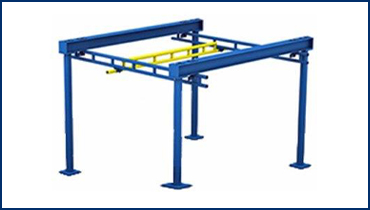
Freestanding Workstation Bridge Cranes
- Capacities up to 4,000-lbs.
- Bridge spans up to 34’.
- 10-lbs force will move a 1K load.
- 5 to 1 design safety factor.
- 10 year warranty.
- Baked on enamel finish.
- Power drive available.
- Many accessory items available
- Stainless steel models available.
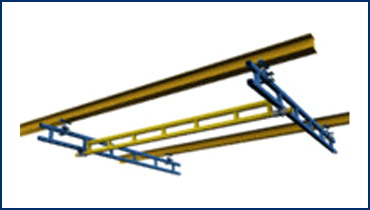
Ceiling Mounted Workstation Bridge Cranes
- Capacities up to 4,000-lbs.
- Bridge spans up to 34’.
- 10-lbs force will move a 1K load.
- 5 to 1 design safety factor.
- 10 year warranty.
- Baked on enamel finish.
- Power drive available.
- Many accessory items available
- Stainless steel models available.
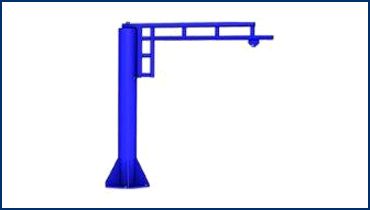
Workstation Jib Cranes
- Capacities up to 1,000-lbs.
- Boom spans up to 16’.
- 360° rotation
- 10-lbs force will move a 1K load.
- 5 to 1 design safety factor.
- 10 year warranty.
- Baked on enamel finish.
- Many accessory items available.
- Wall mounted booms available.
- Stainless steel models available.
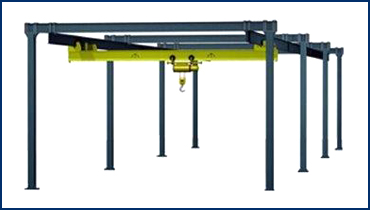
Patented Track Bridge Cranes
- Capacities up to 50-tons.
- Bridge spans up to 50’.
- Power drive functions.
- Severe Duty applications.
- 10 year warranty.
- Baked on enamel finish.
- Freestanding and building supported systems available
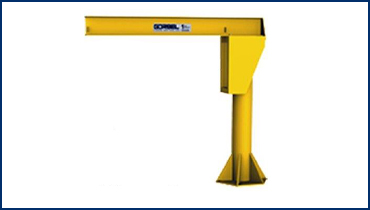
I-Beam Jib Cranes
- Capacities up to 5-tons.
- Boom spans up to 20’.
- 360° rotation
- Severe duty compliant.
- 10 year warranty.
- Baked on enamel finish.
- Powered Rotation available.
- Wall mounted booms available
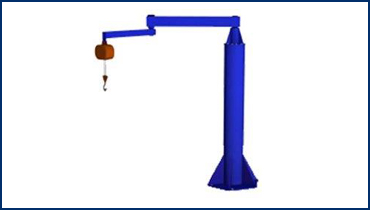
Articulated Jib Cranes
- Capacities up to 2-tons.
- Boom spans up to 16’.
- 360° rotation
- Reach around abstractions.
- Reach through doorways.
- 10 year warranty.
- Baked on enamel finish.
- Powered Rotation available.
- Wall mounted booms available.
- Ceiling mounted configurations available.
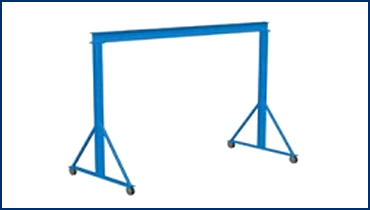
Gantry Cranes
- Capacities up to 3-tons.
- Bridge spans up to 25’.
- Fixed & adjustable height models available.
- 5 to 1 design safety factor.
- 10 year warranty.
- Baked on enamel finish.
- Powered trolley drive available.
- Aluminum models available.
- Many accessory items available.
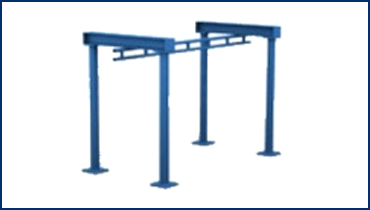
Workstation Mono-Rails
- Capacities up to 4,000-lbs.
- 90° curves available.
- 10-lbs force will move a 1K load.
- 5 to 1 design safety factor.
- 10 year warranty.
- Baked on enamel finish.
- Power drives available.
- Ceiling mounted systems available.
- Stainless steel models available.
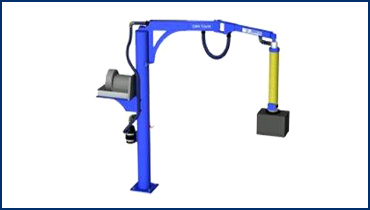
High-Speed Articulated Jib Cranes
- Capacities up to 150-lbs.
- Boom spans up to 12’.
- 360° rotation.
- Ideally suited for vacuum tube lifters.
- Reach around abstractions.
- Reach through doorways.
- 10 year warranty.
- Baked on enamel finish.
- Wall mounted booms available.
- Ceiling mounted configurations available.
For the safe, productive, ergonomic handling of all overhead lifting requirements.
More and more businesses are choosing the enclosed track workstation crane system. As an innovator and leader in the industry, ASE provides a wide variety of overhead workstation crane solutions. Our work station systems include free standing work station bridge cranes (covered in the following pages), ceiling mounted bridge cranes, monorails, and work station jib cranes. And we’re also a leading manufacturer of high-performance manual and motorized jib cranes; all this, plus quick delivery and the industry’s best warranty. (250-lb to 4,000-lb bridge capacities, 2’ to 34’ bridge lengths, 10’ to 100’+ runway length and 10’, 12’ & 14’+ trolley saddles heights)
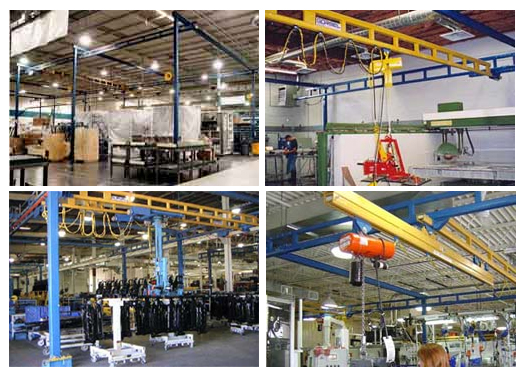
How To Apply Ergonomic Overhead Workstation Cranes
What Type of Crane Is Most Appropriate?
- Bridge cranes cover rectangular areas, while jib cranes cover circular areas.
- Work Station bridge cranes can be floor supported or hung from the ceiling. Jib cranes can be wall or pillar mounted and may require a special foundation.
- An enclosed track workstation bridge crane provides consistent ease of operation over the full range of movement.
- Jib cranes move more easily at the very end of the boom and are more difficult to move as the load approaches the pivot point.
Should the crane be manual or motorized?
Ease of movement and light weight are key features of enclosed track workstation crane systems. In fact, manual workstation cranes do the job faster than motorized cranes. If the operator cannot control the load throughout the operation (for instance, over a vat, pit, or other inaccessible area), then the crane should be motorized.
What type of suspension: free standing or ceiling mounted?
- Free standing (floor-supported) systems do not put stress on the building’s overhead structure. Installation is usually more straightforward, and these cranes are also easier to relocate in the future. These systems require a reinforced concrete floor of at least 6 inches.
- With ceiling mounted systems, supporting steel does not interfere with the handling operation. Ceiling mounted systems require a building with an adequate overhead structure to hang the crane.
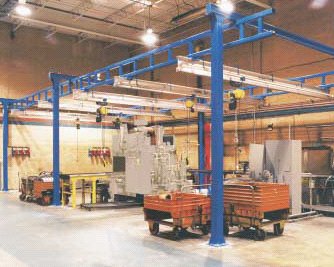
These questions and answers can help you determine which type of overhead work station crane best meets your needs.
What capacity, bridge length, and height?
The general rule is “less is more.”
- Keep capacities to a minimum. Work Station Cranes are designed with an adequate safety factor. If you “over-buy capacity,” the operator will need to move extra bridge dead weight, which would not be a good ergonomic solution.
- Keep bridge lengths to a minimum. The less dead weight an operator has to move, the better. Short bridge lengths are better for higher-cycle production areas. Longer bridges are acceptable for lower-production cycle or maintenance areas.
- Keep bridge heights (trolley saddle) to a minimum- keeping the trolley saddle (TS) height less than 14 feet is desirable because it makes it easier to control and position the load.
Can the operator safely move the load?
- A work cell should be designed so a task can be performed by 90% of the workers.
- A worker should not exceed 33% of his or her capacity; otherwise, the risk of chronic fatigue increases.
Enclosed Track Design Makes for Easy Movement and Long Life
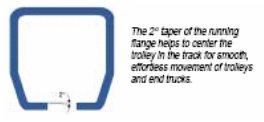
Both the aluminum and steel Work Station Crane Systems utilize enclosed track that is high in strength and low in weight. Major advantages:
- Enclosed track cranes are up to three times easier to move than traditional bridge cranes.
- The design virtually eliminates dirt and dust from the rolling surface, thus reducing wear on the wheels of the trolley and end trucks.
- The smooth running surface means lower rolling resistance.
- The low profile of the steel track allows the system to be installed where headroom is a problem.
- The low track weight reduces the applied forces exerted on the supporting structure.
- Long spans allow systems to be installed where support assemblies are infrequent (up to 30 feet with steel truss design). This reduces the possibility of the support columns interfering with the work cell layout.
- Four distinct sizes of track — 250, 500, 1000, and 2000 series – enable you to keep bridge weights and costs to a minimum.
TRUSSED STEEL TRACK:
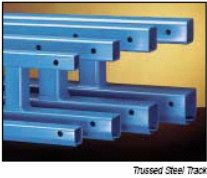
Permits longer spans which allow more flexibility in crane layout.
The trussed series uses the plain steel track profile but is enhanced for longer spans via a built-up truss design. This design increases the span, which decreases the need for frequent hangers. Model numbers start with: GLCS-FS for spans up to 20 feet, GLCSL-FS for spans up to 25 feet, and GLCSLX-FS for spans up to 30 feet. Long spans translate into fewer runway support points, less interference of work cell layout, longer bridge lengths, and free standing capabilities… just another reason why Work Station Cranes are among the most versatile to apply and easiest to install in the industry.
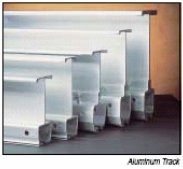 ALUMINUM TRACK:
ALUMINUM TRACK:
For use where lower bridge weight and easier movement are requiredThe patented shape of ASE’s aluminum enclosed track provides for low weight, unparalleled spanning capability, and effortless movement. The low weight (up to 44% less than trussed steel track) results in easier movement, which makes for safe, productive, ergonomic work cells. Runway spans up to 20 feet and bridge lengths up to 34 feet meet a wide range of applications. Model numbers start with AL-FS.
Rigid Runways Provide for Superior Positioning of Loads
Work Station Bridge Cranes are installed so that the runways are rigid. They do not move laterally or longitudinally. In addition, the floating end trucks with horizontal wheels prevent binding. The combination of these design features results in unmatched ease of positioning and ease of movement. The bridge travels smoothly down the runways, and movement is unvarying along the way, no matter where a load is positioned on the bridge. This allows superior load positioning. Another advantage of rigid runways is that runways double as stringers between support columns. This eliminates the need for expensive intermediate support stringers, and it lowers overall installation cost.
Mixed Capacity Bridge Crane Systems:
Reduced bridge dead weight equals better ergonomic solutions.
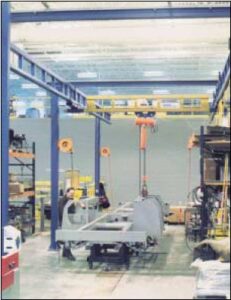 Mixed-capacity systems allow multiple lower capacity bridges to be used on higher capacity runways, provided the equivalent center loads (ECL) are verified at the factory to ensure that runways and hangers are not overloaded. For example, using ASE’s mixed-capacity end trucks, four 500 lb. bridges (utilizing 500 series rail) can be hung from a 2000 lb. runway, allowing side-by-side use of all four bridges without overloading the system. By mixing bridges of various sizes and capacities, mixed-capacity systems offer reduced bridge dead weight, easier movement, and reduced cost.
Mixed-capacity systems allow multiple lower capacity bridges to be used on higher capacity runways, provided the equivalent center loads (ECL) are verified at the factory to ensure that runways and hangers are not overloaded. For example, using ASE’s mixed-capacity end trucks, four 500 lb. bridges (utilizing 500 series rail) can be hung from a 2000 lb. runway, allowing side-by-side use of all four bridges without overloading the system. By mixing bridges of various sizes and capacities, mixed-capacity systems offer reduced bridge dead weight, easier movement, and reduced cost.
Call 800-245-2163 for pricing & additional information.
WARNING: Equipment described in this brochure is not designed for, and should not be used for, lifting, supporting, or transporting humans. Failure to comply with any one of the limitations noted can result in serious bodily injury and/or property damage.
Easy to Install
Free Standing Work Station Bridge Cranes can be installed on any normal 6″ reinforced concrete floor. Each column is anchored by four bolts, thus eliminating the need for field welding. Support columns are designed to AISC specifications. If no movement of the support assemblies is required, then bracing to the building is recommended (not included).
Modular Design
The pre-engineered modular kit design permits easy expansion or relocation. The runway length can be increased by adding runway sections, free standing support assemblies and additional bridges as needed.
What is meant by Rated Capacity?
The rated capacity is the live load that can be lifted by the crane system. The design load for the crane system is based on the rated capacity plus 15% for the weight of the hoist and trolley (capacity _ 1.15) and an additional 25% for impact (capacity _ 1.25) for a total design of capacity _ 1.4 (Note, 25% impact factor is good for hoist speeds up to 50 f.p.m.). For example, a 1000-lb. ASE cranes allows you to pick up a 1000 lb. load provided the hoist weighs 150 lb. or less and the hoist speed is less than 50 feet per minute.
Design load for deflection calculations is based on the rated capacity plus 15% for the weight of the hoist and trolley (capacity _ 1.15). Under no conditions should the crane be loaded beyond its rated capacity. Work Station Cranes meet or exceed the ANSI B30.11 specifications for under hung bridge cranes.
SPLICE JOINTS FOR STEEL TRACK A splice joint is used to join track sections together and enable the installer to quickly and properly align the joined sections of track. Adjusting bolts are provided on the splice joint for leveling and aligning.
A splice joint is used to join track sections together and enable the installer to quickly and properly align the joined sections of track. Adjusting bolts are provided on the splice joint for leveling and aligning.
Call 800-245-2163 for pricing & additional information.
Hangers for Trussed Steel Track
Hangers for steel runways are included with each assembly as shown. The runways are flush mounted under the free standing support assemblies via spine clamp angles, B7 alloy threaded rods, and the appropriate hardware.
Call 800-245-2163 for pricing & additional information.
SPLICE JOINTS FOR ALUMINUM TRACK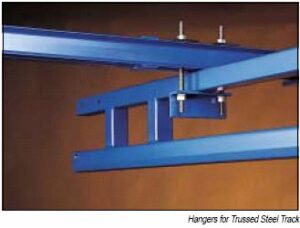
 Patented splice joints for aluminum track allow for precision alignment. The aluminum track is extruded with four patented alignment slots. Four precision-ground pins are provided to accurately align runway sections, which provides for a smoother transition of wheels over the splice joint than is possible with bolted connections. In addition, clamp fasteners attach to the vertical web of the track to pull the track together and keep it from separating.
Patented splice joints for aluminum track allow for precision alignment. The aluminum track is extruded with four patented alignment slots. Four precision-ground pins are provided to accurately align runway sections, which provides for a smoother transition of wheels over the splice joint than is possible with bolted connections. In addition, clamp fasteners attach to the vertical web of the track to pull the track together and keep it from separating.
Hangers for Aluminum Track
Standard hangers for aluminum runways are included with each assembly shown. The runways are flush mounted under the free standing support assemblies via beam clips, B7 alloy threaded rods, and the appropriate hardware.
FREE STANDING WORK STATION BRIDGE CRANES
STEEL RUNWAYS WITH STEEL OR ALUMINUM BRIDGE ISOMETRIC VIEW
Call 800-245-2163 for pricing & additional information.
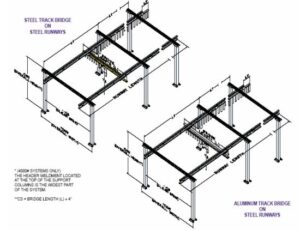 Free Standing Work Station Crane kits include: bridge, runways, the appropriate number of support assemblies, hoist trolley, end trucks, end stops, flat wire festooning, festoon gliders (festoon trolleys on steel runway lengths greater than 63′ and all aluminum systems), festoon stack-up section, splice joints and hanger brackets.
Free Standing Work Station Crane kits include: bridge, runways, the appropriate number of support assemblies, hoist trolley, end trucks, end stops, flat wire festooning, festoon gliders (festoon trolleys on steel runway lengths greater than 63′ and all aluminum systems), festoon stack-up section, splice joints and hanger brackets.
Hoist and anchor bolts provided by others.
Dimensions are for reference only and are subject to change without notice.
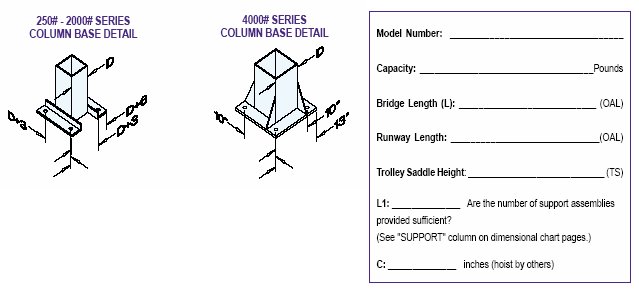
Click the following links to view Work Station Jib Cranes, Multiple Bridge Options, and Work Station Crane Component Parts
Have Question/Query? Fill this Form to send us a message, we will get back to you shortly!
